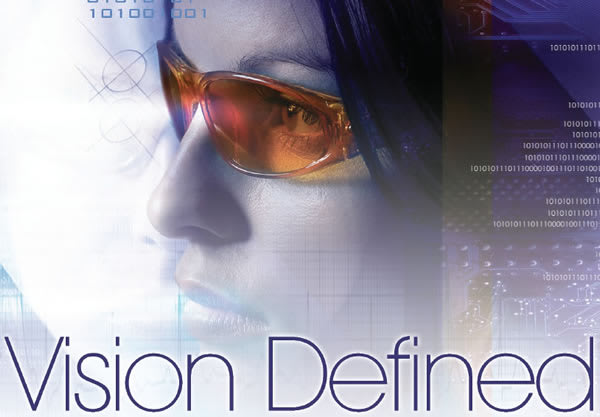
By Karlen McLean, ABOC, NCLC
Freeform technology from Shamir Insight (above) is available in a variety of the firm’s offerings
Plug in your high-resolution sound system, push the button on your
digital camera, and tune in your high-definition television.
Spectacle lenses are the next high-definition gadget
that you and your patients have to get!
Defining free-form in exact terms may be impossible due to the individual patents, copyrights, and nuances created by lens manufacturers and labs. In general terms, free-form technology, without regard to proprietary factors, is a method of designing and manufacturing lenses that optimizes the wearer’s vision without the constraints of standard base curve selection and other traditional optical design and fabrication principles.
Free-form technology—also known as digital surfacing or direct-to-surface—utilizes different methods and operating systems to achieve results. But, the goal of these processes is the same: to give the wearer better vision than they would otherwise experience by using conventional lens design and fabrication.
Here’s a look at these technologies and how they can benefit your practice and your patient’s vision.
STEP-BY-STEP
There are basically four steps to free-form lens delivery.
1. Design. Design is achieved through research and development. Scientific applications are transferred to software, which then in turn drives the production process.
Current free-form designs include optimized designs that precisely create the lens’ surface to minimize aberrations and personalized or individualized designs that take into account the wearer’s Rx, visual ergonomics, and even frame size and shape and eye shape, depending on manufacturer parameters.
One thing to keep in mind is that manufacturers are improving designs and computer programs all of the time, so new upgrades of previous free-form designs, as well as brandnew ones, will be a regular part of the free-form marketplace.
2. Labs. Laboratories with specialized free-form-capable equipment are essential to the success of the free-form process. Currently, there are two free-form lab delivery systems—manufacturer labs and independent labs. Software “point” files drive freeform production by calculating the prescription complexities, resulting in mathematical formulas that guide the equipment in precisely surfacing the lenses. Deep branding is important at the processing end as well as to consumers, as manufacturers and labs increasingly market their proprietary free-form lens designs to ECPs.
3. ECPs. Eyecare practitionerfocused free-form training seminars are plentiful and steadily expanding. For example, one free-form lens manufacturer currently has at least 22 executives giving free-form seminars in the U.S., along with three directors who teach PAL and occupational lens topics.
Now is the time to learn and grasp what free-form is about. Then, even if you’re in a watch-and-wait mode, you’ll be up to speed when the time comes for your practice to embrace free-form lens technology.
Contact manufacturers for information on their particular free-form designs and get training. When that’s taken care of, you’ll be ready to make hard decisions on which products you’ll work with and present to your patients.

|

|
Upgrades of free-form technology are happening all of the time, and the trend of frequent improvements is expected to continue well into the future. Shown left to right: Hoya Hoyalux iD, Carl Zeiss Vision, and driver Liz Halliday in Ophthonix iZone wavefront lenses
4. Consumers. Consumers’ freeform lens purchases are based on ECP recommendations, personal research, advertising, and the initial assumptions they make about the lenses to justify the cost. Consumers are also brand-driven and may recognize a particular manufacturer’s ad, logo, and name, even in the lens arena. High-end consumers are often brand conscious, and they may be willing to pay more for their lenses than their frames for the first time in their lives—if they hear a little about the company behind the product as well as basic free-form lens benefits. Patients usually want to see the best that they can see. As a result, in today’s technology-driven society, their understanding and buy-in of technologically advanced lenses is more likely.

CATCH A WAVE
Wavefront technology measures and analyzes light waves to determine the light wave’s optical path. Peaks and waves of light, which travel in all directions from the source, create a wavefront. Wavefront can be measured to determine the surface geometry of the cornea using corneal surface mapping. Wavefront technology not only helps analyze vision but also is applied to help control the natural aberrations of the eye to achieve sharper vision via wavefront-created free-form lenses.
Be aware of what drives consumer interest in free-form product. Images provided by: Seiko, above, and Signet Armorlite, right |

|
By harnessing wavefront analysis, complex mathematical design, and free-form processing, both higher and lower order visual aberrations are controlled. This results in highly defined vision, including reduced halos or flare and increased binocular vision, color perception and contrast.
While everyone can benefit from highly defined vision, three groups are the strongest contenders:
1. Those with complex and/or high-powered distance corrections are most likely to immediately see the difference when they put on their wavefront-designed lenses.
2. Former progressive non-adapts are more likely to be successful with wavefront-created PALs.
3. Anyone who demands or desires top-notch visual acuity will appreciate the latest in lens technology.

PLAIN BENEFITS
To truly take hold in the market, ECPs must show patients that freeform products can add value. As one manufacturer executive puts it, “Free-form is changing how the U.S. marketplace is selling.”
In Europe, free-form lens usage is currently estimated to be around 20 percent, while U.S. usage is approximately in the single digits. Experts agree that the current costs of equipment, production, and lenses at retail has created, at least for now, an elite group of manufacturers, labs, ECPs, and patients who envision the benefits of free-form and are willing to pay top dollar.
Cost, while likely the primary concern, isn’t the only roadblock. Free-form is something new. Newer, even if better, takes some time to catch on. Another manufacturing executive notes, “Free-form today is like going from glass to plastic lenses was years ago.”
When explaining free-form lenses, emphasize digital technology: most patients recognize that digitalization is better from the electronics industry in cameras or televisions and realize that digital applications create better vision.





